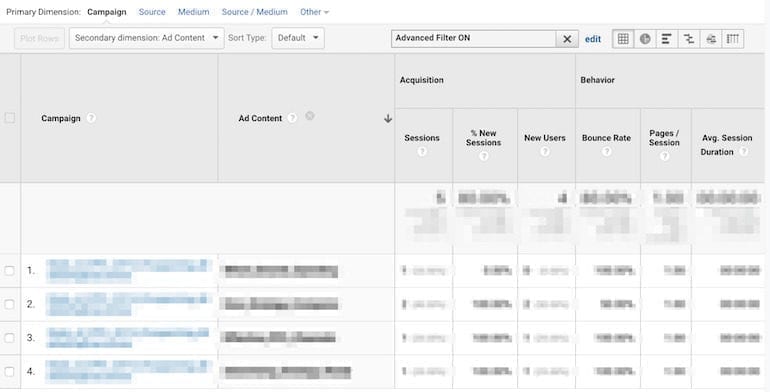What Is A Secondary Dimension In Google Analytics for Beginners
Wiki Article
What Is A Secondary Dimension In Google Analytics Fundamentals Explained
Table of ContentsLittle Known Facts About What Is A Secondary Dimension In Google Analytics.Getting My What Is A Secondary Dimension In Google Analytics To WorkThe Facts About What Is A Secondary Dimension In Google Analytics RevealedWhat Does What Is A Secondary Dimension In Google Analytics Mean?What Is A Secondary Dimension In Google Analytics for BeginnersSome Known Incorrect Statements About What Is A Secondary Dimension In Google Analytics
Its measurements can be (however are not restricted to): Purchase ID Discount coupon code Newest traffic resource, and so on. That event's personalized measurements may be: Login method Customer ID, etc.Thus personalized dimensions are needed. In Google Analytics, you will certainly not find any type of measurements associated particularly to online programs.

Enter Custom-made Dimensions. In this blog site article, I will not dive deeper into custom-made measurements in Universal Analytics.
What Is A Secondary Dimension In Google Analytics Things To Know Before You Get This
The scope specifies to which events the dimension will use. In Universal Analytics, there were four extents: User-scoped customized dimensions are related to all the hits of a user (hit is an occasion, pageview, and so on). If you send out User ID as a custom measurement, it will certainly be applied to all the hits of that certain session And also to all the future hits sent out by that user (as long as the GA cookie remains the same).As an example, you can send out the session ID personalized dimension, and also even if you send it with the last occasion of the session, all the previous occasions (of the same session) will certainly get the value. This is carried out in the backend of Google Analytics. measurement applies only to that certain event/hit (with which the dimension was sent out).
That measurement will be applied just to the "trial started" event. Product-scoped custom-made measurement uses only to a specific item (that is tracked with Boosted Ecommerce capability). Even if you send several items with the exact same deal, each item might have various values in their product-scoped personalized dimensions, e. g.
The Main Principles Of What Is A Secondary Dimension In Google Analytics
Why am I telling you this? Because some things have actually transformed in Google Analytics 4. In Google Analytics 4, the session extent is no much longer offered (at least in personalized dimensions). Google said they would certainly include session-scope in the future to GA4. If you intend to apply a dimension to all the occasions of a specific session, you need to send out that dimension with every occasion (that can be done on the code level (gtag) or in GTM).It can be in a cookie, data layer, or elsewhere. From currently on, customized measurements are either hit-scoped or user-scoped (formerly called Individual Properties). User-scoped custom-made measurements in GA4 job in a similar way to the user-scoped measurements in Universal Analytics but with some differences: In Universal Analytics, a user-scoped custom measurement (collection Homepage in the middle of the individual session) was put on EVERY occasion of the same session (even if some occasion took place before the dimension was set).
How What Is A Secondary Dimension In Google Analytics can Save You Time, Stress, and Money.
Although you can send out custom-made item data to GA4, presently, there is no other way to see it in records effectively. With any luck, this will certainly be transformed in the future. Or am I missing out on something? (let me know). GA4 currently sustains item-scoped custom-made dimensions. At some time in the past, Google claimed that session-scoped personalized measurements in GA4 would be available too.But when it comes to custom measurements, this scope is still not readily available. As well as currently, let's relocate to the 2nd component of this article, where I will certainly show you just how to configure personalized dimensions and also where to locate them in Google Analytics 4 records. Allow me start with a general review of the process, and also then we'll take a look at an instance.
You can just send the event name, investigate this site state, "joined_waiting_list" and also then consist of the parameter "course_name".
The Only Guide for What Is A Secondary Dimension In Google Analytics
Because situation, you will require to: Register a criterion as a personalized interpretation Start sending custom parameters with the events you desire The order DOES NOT issue right here. You need to do that rather a lot at the very same time. If you begin sending out the specification to Google Analytics 4 and only register it as a custom-made measurement, state, one week later on, your records will certainly be missing that one week of information (since the registration of a customized measurement is not retroactive).Every single time a site visitor clicks on a food selection thing, I will send out an event and 2 extra criteria (that I will later sign up as custom-made dimensions), menu_item_url, and also menu_item_name.: Menu link click monitoring trigger conditions differ on many websites (as a result of different click courses, IDs, etc). Attempt to do your finest to apply this instance.
Most Likely To Google Tag Manager > Activates > New > Simply Links. What Is A Secondary Dimension In Google Analytics. Maintain the trigger set to "All web link clicks" as well as conserve the trigger. By creating this trigger, we will certainly enable the link-tracking investigate this site capability in Google Tag Manager. After that most likely to Variables > Configure (in the "Built-in Variables" area) and make it possible for all Click-related variables.
The Single Strategy To Use For What Is A Secondary Dimension In Google Analytics
Go to your web site as well as click any of the menu links. Click the first Link, Click event and go to the Variables tab of the sneak peek mode.
Report this wiki page